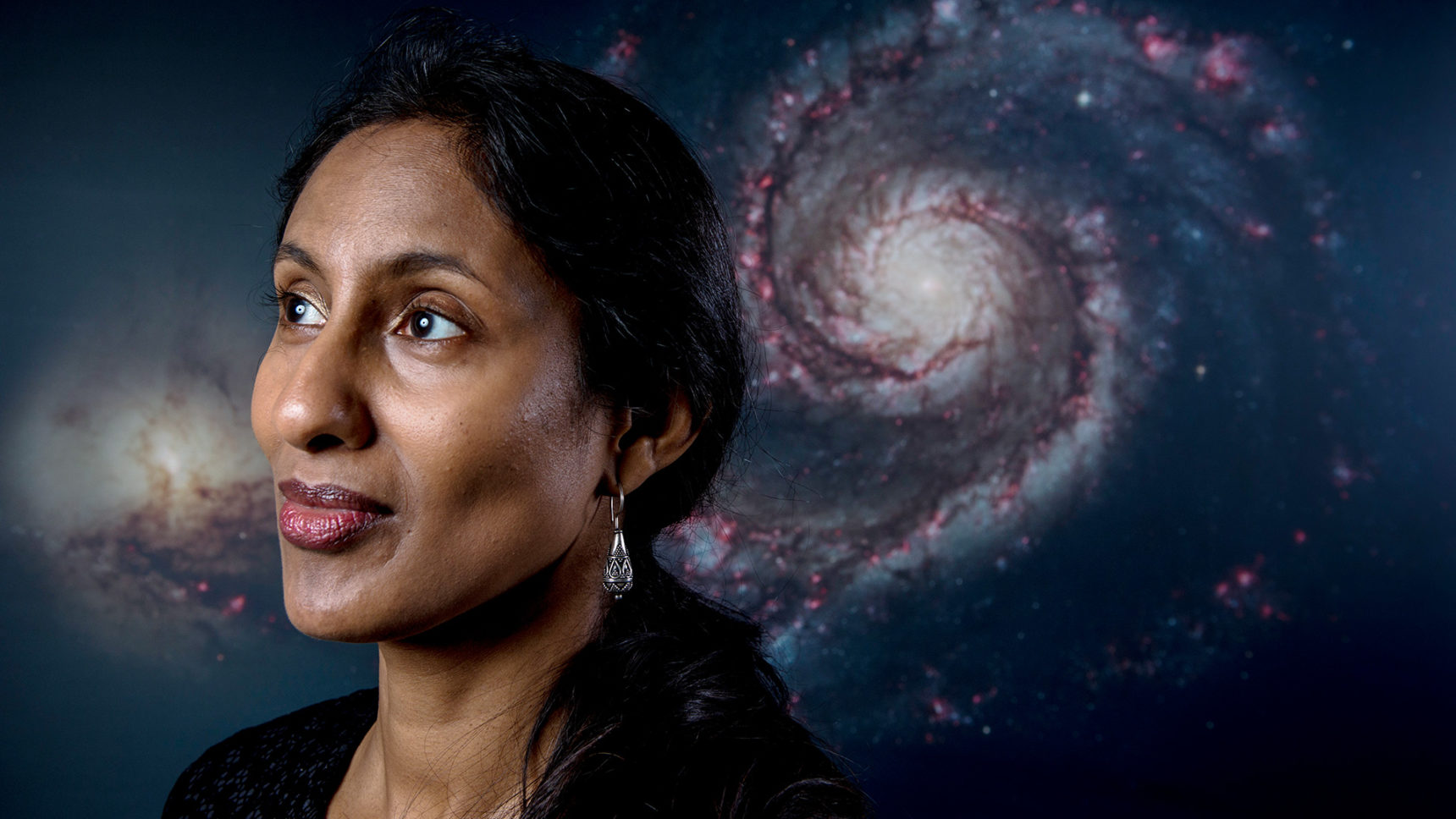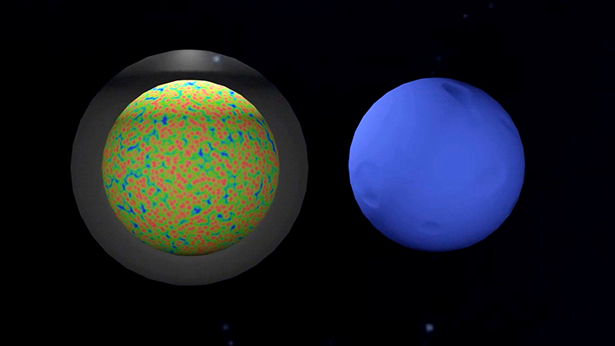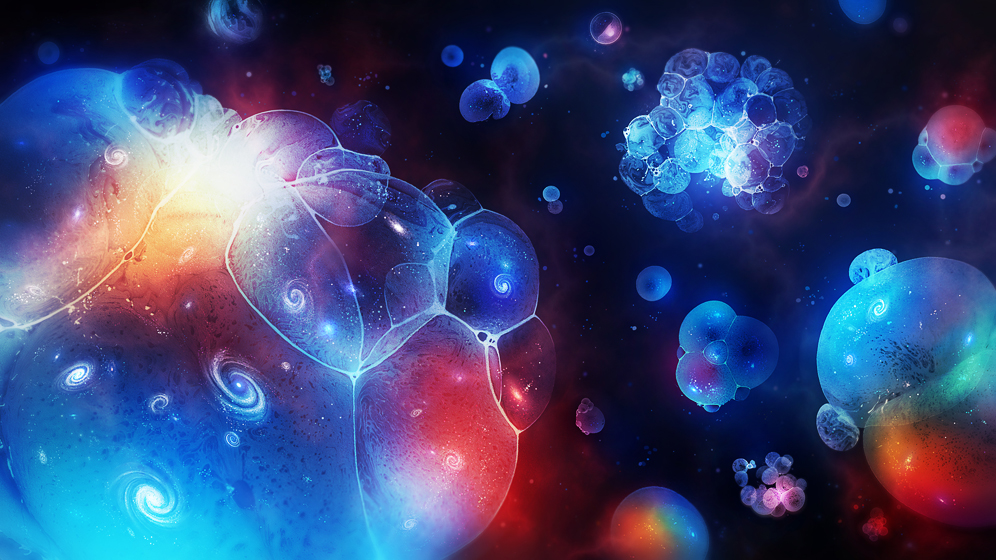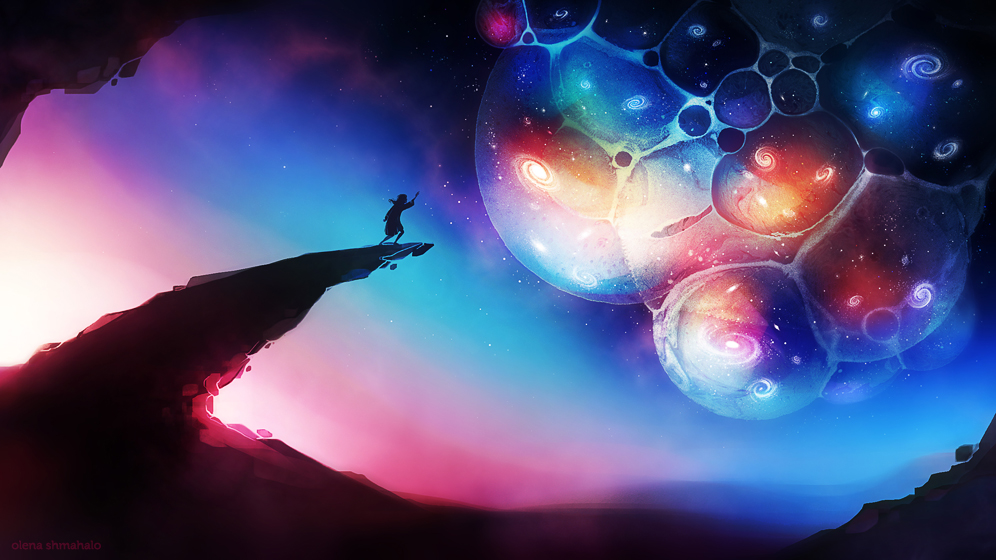
Physicists are searching for evidence of an ancient collision with another universe.
Olena Shmahalo/Quanta Magazine
Introduction
Like many of her colleagues, Hiranya Peiris, a cosmologist at University College London, once largely dismissed the notion that our universe might be only one of many in a vast multiverse. It was scientifically intriguing, she thought, but also fundamentally untestable. She preferred to focus her research on more concrete questions, like how galaxies evolve.
Then one summer at the Aspen Center for Physics, Peiris found herself chatting with the Perimeter Institute’s Matt Johnson, who mentioned his interest in developing tools to study the idea. He suggested that they collaborate.
At first, Peiris was skeptical. “I think as an observer that any theory, however interesting and elegant, is seriously lacking if it doesn’t have testable consequences,” she said. But Johnson convinced her that there might be a way to test the concept. If the universe that we inhabit had long ago collided with another universe, the crash would have left an imprint on the cosmic microwave background (CMB), the faint afterglow from the Big Bang. And if physicists could detect such a signature, it would provide a window into the multiverse.
Erick Weinberg, a physicist at Columbia University, explains this multiverse by comparing it to a boiling cauldron, with the bubbles representing individual universes — isolated pockets of space-time. As the pot boils, the bubbles expand and sometimes collide. A similar process may have occurred in the first moments of the cosmos.
In the years since their initial meeting, Peiris and Johnson have studied how a collision with another universe in the earliest moments of time would have sent something similar to a shock wave across our universe. They think they may be able to find evidence of such a collision in data from the Planck space telescope, which maps the CMB.
The project might not work, Peiris concedes. It requires not only that we live in a multiverse but also that our universe collided with another in our primal cosmic history. But if physicists succeed, they will have the first improbable evidence of a cosmos beyond our own.
When Bubbles Collide
Multiverse theories were once relegated to science fiction or crackpot territory. “It sounds like you’ve gone to crazy land,” said Johnson, who holds joint appointments at the Perimeter Institute of Theoretical Physics and York University. But scientists have come up with many versions of what a multiverse might be, some less crazy than others.
The multiverse that Peiris and her colleagues are interested in is not the controversial “many worlds” hypothesis that was first proposed in the 1950s and holds that every quantum event spawns a separate universe. Nor is this concept of a multiverse related to the popular science-fiction trope of parallel worlds, new universes that pinch off from our space-time and become separate realms. Rather, this version arises as a consequence of inflation, a widely accepted theory of the universe’s first moments.
Inflation holds that our universe experienced a sudden burst of rapid expansion an instant after the Big Bang, blowing up from a infinitesimally small speck to one spanning a quarter of a billion light-years in mere fractions of a second.
Yet inflation, once started, tends to never completely stop. According to the theory, once the universe starts expanding, it will end in some places, creating regions like the universe we see all around us today. But elsewhere inflation will simply keep on going eternally into the future.
This feature has led cosmologists to contemplate a scenario called eternal inflation. In this picture, individual regions of space stop inflating and become “bubble universes” like the one in which we live. But on larger scales, exponential expansion continues forever, and new bubble universes are continually being created. Each bubble is deemed a universe in its own right, despite being part of the same space-time, because an observer could not travel from one bubble to the next without moving faster than the speed of light. And each bubble may have its own distinct laws of physics. “If you buy eternal inflation, it predicts a multiverse,” Peiris said.
In 2012, Peiris and Johnson teamed up with Anthony Aguirre and Max Wainwright — both physicists at the University of California, Santa Cruz — to build a simulated multiverse with only two bubbles. They studied what happened after the bubbles collided to determine what an observer would see. The team concluded that a collision of two bubble universes would appear to us as a disk on the CMB with a distinctive temperature profile.
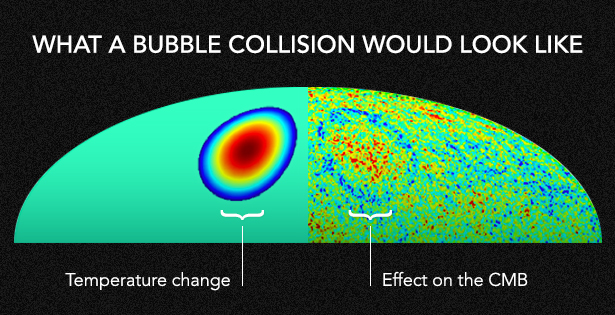
To guard against human error — we tend to see the patterns we want to see — they devised a set of algorithms to automatically search for these disks in data from the Wilkinson Microwave Anisotropy Probe (WMAP), a space-based observatory. The program identified four potential regions with temperature fluctuations consistent with what could be a signature of a bubble collision. When data from the Planck satellite becomes available later this year, researchers should be able to improve on that earlier analysis.
Yet detecting convincing signatures of the multiverse is tricky. Simply knowing what an encounter might look like requires a thorough understanding of the dynamics of bubble collisions — something quite difficult to model on a computer, given the complexity of such interactions.
When tackling a new problem, physicists typically find a good model that they already understand and adapt it by making minor tweaks they call “perturbations.” For instance, to model the trajectory of a satellite in space, a physicist might use the classical laws of motion outlined by Isaac Newton in the 17th century and then make small refinements by calculating the effects of other factors that might influence its motion, such as pressure from the solar wind. For simple systems, there should be only small discrepancies from the unperturbed model. Try to calculate the airflow patterns of a complex system like a tornado, however, and those approximations break down. Perturbations introduce sudden, very large changes to the original system instead of smaller, predictable refinements.
Modeling bubble collisions during the inflationary period of the early universe is akin to modeling a tornado. By its very nature, inflation stretches out space-time at an exponential rate — precisely the kind of large jumps in values that make calculating the dynamics so challenging.
“Imagine you start with a grid, but within an instant, the grid has expanded to a massive size,” Peiris said. With her collaborators, she has used techniques like adaptive mesh refinement — an iterative process of winnowing out the most relevant details in such a grid at increasingly finer scales — in her simulations of inflation to deal with the complexity. Eugene Lim, a physicist at King’s College London, has found that an unusual type of traveling wave might help simplify matters even further.
Waves of Translation
In August 1834, a Scottish engineer named John Scott Russell was conducting experiments along Union Canal with an eye toward improving the efficiency of the canal boats. One boat being drawn by a team of horses stopped suddenly, and Russell noted a solitary wave in the water that kept rolling forward at a constant speed without losing its shape. The behavior was unlike typical waves, which tend to flatten out or rise to a peak and topple quickly. Intrigued, Russell tracked the wave on horseback for a couple of miles before it finally dissipated in the channel waters. This was the first recorded observation of a soliton.
Russell was so intrigued by the indomitable wave that he built a 30-foot wave tank in his garden to further study the phenomenon, noting key characteristics of what he called “the wave of translation.” Such a wave could maintain size, shape and speed over longer distances than usual. The speed depended on the wave’s size, and the width depended on the depth of the water. And if a large solitary wave overtook a smaller one, the larger, faster wave would just pass right through.
Russell’s observations were largely dismissed by his peers because his findings seemed to contradict what was known about water wave physics at the time. It wasn’t until the mid-1960s that such waves were dubbed solitons and physicists realized their usefulness in modeling problems in diverse areas such as fiber optics, biological proteins and DNA. Solitons also turn up in certain configurations of quantum field theory. Poke a quantum field and you will create an oscillation that usually dissipates outward, but configure things in just the right way and that oscillation will maintain its shape — just like Russell’s wave of translation.
Because solitons are so stable, Lim believes they could work as a simplified toy model for the dynamics of bubble collisions in the multiverse, providing physicists with better predictions of what kinds of signatures might show up in the CMB. If his hunch is right, the expanding walls of our bubble universe are much like solitons.
However, while it is a relatively straightforward matter to model a solitary standing wave, the dynamics become vastly more complicated and difficult to calculate when solitons collide and interact, forcing physicists to rely on computer simulations instead. In the past, researchers have used a particular class of soliton with an exact mathematical solution and tweaked that model to suit their purposes. But this approach only works if the target system under study is already quite similar to the toy model; otherwise the changes are too large to calculate.
To get around that hurdle, Lim devised a neat trick based on a quirky feature of soliton collisions. When imagining two objects colliding, we naturally assume that the faster they are moving, the greater the impact and the more complicated the dynamics. Two cars ramming each other at high speeds, for instance, will produce scattered debris, heat, noise and other effects. The same is true for colliding solitons — at least initially. Collide two solitons very slowly, and there will be very little interaction, according to Lim. As the speed increases, the solitons interact more strongly.
But Lim found that as the speed continues to increase, the pattern eventually reverses: The soliton interaction begins to decrease. By the time they are traveling at the speed of light, there is no interaction at all. “They just fly right past each other,” Lim said. “The faster you collide two solitons, the simpler they become.” The lack of interactions makes it easier to model the dynamics of colliding solitons, as well as colliding bubble universes with solitons as their “edges,” since the systems are roughly similar.
According to Johnson, Lim has uncovered a very simple rule that can be applied broadly: Multiverse interactions are weak during high-speed collisions, making it easier to simulate the dynamics of those encounters. One can simply create a new model of the multiverse, use solitons as a tool to map the new model’s expected signatures onto cosmic microwave data, and rule out any theories that don’t match what researchers see. This process would help physicists identify the most viable models for the multiverse, which — while still speculative — would be consistent both with the latest observational data and with inflationary theory.
The Multiverse’s Case for String Theory
One reason that more physicists are taking the idea of the multiverse seriously is that certain such models could help resolve a significant challenge in string theory. One of the goals of string theory has been to unify quantum mechanics and general relativity, two separate “rule books” in physics that govern very different size scales, into a single, simple solution.
But around 10 years ago, “the dream of string theory kind of exploded,” Johnson said — and not in a good way. Researchers began to realize that string theory doesn’t provide a unique solution. Instead, it “gives you the theory of a vast number of worlds,” Weinberg said. A common estimate — one that Weinberg thinks is conservative — is 10500 possibilities. This panoply of worlds implies that string theory can predict every possible outcome.
The multiverse would provide a possible means of incorporating all the different worlds predicted by string theory. Each version could be realized in its own bubble universe. “Everything depends on which part of the universe you live in,” Lim said.
Peiris acknowledges that this argument has its critics. “It can predict anything, and therefore it’s not valid,” Peiris said of the reasoning typically used to dismiss the notion of a multiverse as a tautology, rather than a true scientific theory. “But I think that’s the wrong way to think about it.” The theory of evolution, Peiris argues, also resembles a tautology in certain respects — “an organism exists because it survived” — yet it holds tremendous explanatory power. It is a simple model that requires little initial input to produce the vast diversity of species we see today.
A multiverse model tied to eternal inflation could have the same kind of explanatory power. In this case, the bubble universes function much like speciation. Those universes that happen to have the right laws of physics will eventually “succeed” — that is, they will become home to conscious observers like ourselves. If our universe is one of many in a much larger multiverse, our existence seems less unlikely.
Uncertain Signals
Ultimately, however, Peiris’ initial objection still stands: Without some means of gathering experimental evidence, the multiverse hypothesis will be untestable by definition. As such, it will lurk on the fringes of respectable physics — hence the strong interest in detecting bubble collision signatures in the CMB.
Of course, “just because these bubble collisions can leave a signature doesn’t mean they do leave a signature,” Peiris emphasized. “We need nature to be kind to us.” An observable signal could be a rare find, given how quickly space expanded during inflation. The collisions may not have been rare, but subsequent inflation “tends to dilute away the effects of the collision just like it dilutes away all other prior ‘structure’ in the early universe, leaving you with a small chance of seeing a signal in the CMB sky,” Peiris said.
“My own feeling is you need to adjust the numbers rather finely to get it to work,” Weinberg said. The rate of formation of the bubble universes is key. If they had formed slowly, collisions would not have been possible because space would have expanded and driven the bubbles apart long before any collision could take place. Alternatively, if the bubbles had formed too quickly, they would have merged before space could expand sufficiently to form disconnected pockets. Somewhere in between is the Goldilocks rate, the “just right” rate at which the bubbles would have had to form for a collision to be possible.
Researchers also worry about finding a false positive. Even if such a collision did happen and evidence was imprinted on the CMB, spotting the telltale pattern would not necessarily constitute evidence of a multiverse. “You can get an effect and say it will be consistent with the calculated predictions for these [bubble] collisions,” Weinberg said. “But it might well be consistent with lots of other things.” For instance, a distorted CMB might be evidence of theoretical entities called cosmic strings. These are like the cracks that form in the ice when a lake freezes over, except here the ice is the fabric of space-time. Magnetic monopoles are another hypothetical defect that could affect the CMB, as could knots or twists in space-time called textures.
Weinberg isn’t sure it would even be possible to tell the difference between these different possibilities, especially because many models of eternal inflation exist. Without knowing the precise details of the theory, trying to make a positive identification of the multiverse would be like trying to distinguish between the composition of two meteorites that hit the roof of a house solely by the sound of the impacts, without knowing how the house is constructed and with what materials.
Should a signature for a bubble collision be confirmed, Peiris doesn’t see a way to study another bubble universe any further because by now it would be entirely out of causal contact with ours. But it would be a stunning validation that the notion of a multiverse deserves a seat at the testable physics table.
And should that signal turn out to be evidence for cosmic strings or magnetic monopoles instead, it would still constitute exciting new physics at the frontier of cosmology. In that respect, “the cosmic microwave background radiation is the underpinning of modern cosmology,” Peiris said. “It’s the gift that keeps on giving.”
This article was reprinted on Wired.com.
